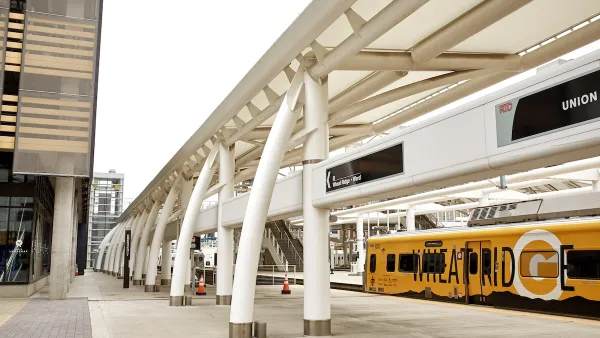A coalition of urbanists, doctors, and pedestrian enthusiasts are working to improve awareness, participation, and amenities for Denver's walkers. And in the least obese state in the country, their efforts are gaining an audience.
According to Walk Denver co-founder Gosia King, "Ample sidewalks are crucial...but they provide only the means of access to an environment that must then reward walkers through attractions like shopping and entertainment that cater specifically to foot traffic."
Kirk Johnson writes that King is leading an effort to make Denver a "Walk Friendly Community, a rating list for pedestrian-friendly cities that bestows Seattle its top "platinum-level" rating.
More walkers, whether strolling or striding, in turn reinforce an old idea that Kung said many cities have forgotten: better public health and improved economic life go together.
She knows the former trait well. Upon moving to the U.S. from Poland in 1997, she "got her driver's license and gained 20 pounds".
History plays a key role in pedestrian-friendly cities, as dense Manhattan illustrates. Denver, "founded in the 1850's Colorado gold rush", laid down a street grid to accommodate the streetcar system, creating a dense ring of nearby 'streetcar suburbs'" that could facilitate both walking and transit.
"Denver city planners had already set a goal of having 15 percent of residents get to their jobs on bike or on foot by 2020, up from about 6 percent according to the most recent census survey."
However, it is unlikely that federal pedestrian funds will be forthcoming as both House and Senate transportation reauthorization bills reduced or stripped that provision.
FULL STORY: Denver Is Urged to Hit the Sidewalks

Planetizen Federal Action Tracker
A weekly monitor of how Trump’s orders and actions are impacting planners and planning in America.

Maui's Vacation Rental Debate Turns Ugly
Verbal attacks, misinformation campaigns and fistfights plague a high-stakes debate to convert thousands of vacation rentals into long-term housing.

Restaurant Patios Were a Pandemic Win — Why Were They so Hard to Keep?
Social distancing requirements and changes in travel patterns prompted cities to pilot new uses for street and sidewalk space. Then it got complicated.

In California Battle of Housing vs. Environment, Housing Just Won
A new state law significantly limits the power of CEQA, an environmental review law that served as a powerful tool for blocking new development.

Boulder Eliminates Parking Minimums Citywide
Officials estimate the cost of building a single underground parking space at up to $100,000.

Orange County, Florida Adopts Largest US “Sprawl Repair” Code
The ‘Orange Code’ seeks to rectify decades of sprawl-inducing, car-oriented development.
Urban Design for Planners 1: Software Tools
This six-course series explores essential urban design concepts using open source software and equips planners with the tools they need to participate fully in the urban design process.
Planning for Universal Design
Learn the tools for implementing Universal Design in planning regulations.
Heyer Gruel & Associates PA
JM Goldson LLC
Custer County Colorado
City of Camden Redevelopment Agency
City of Astoria
Transportation Research & Education Center (TREC) at Portland State University
Jefferson Parish Government
Camden Redevelopment Agency
City of Claremont





























